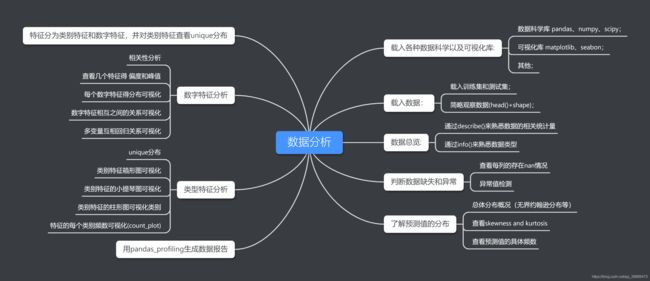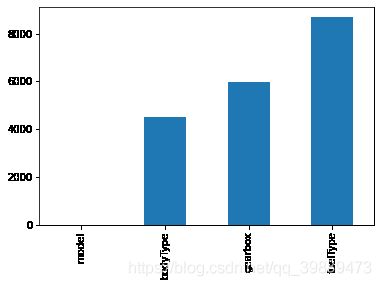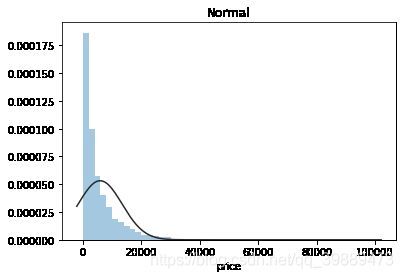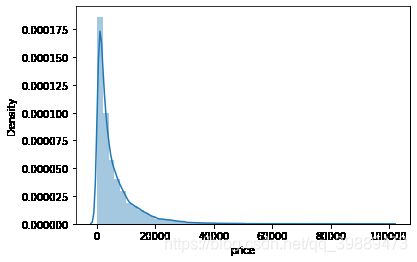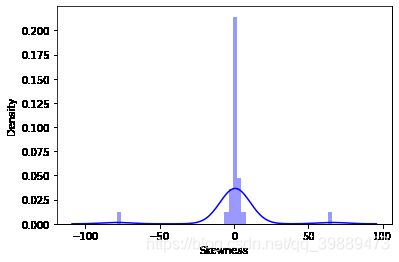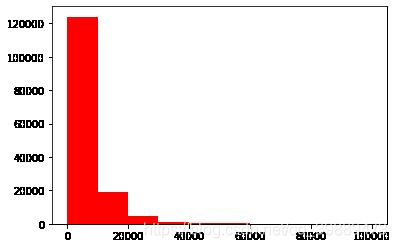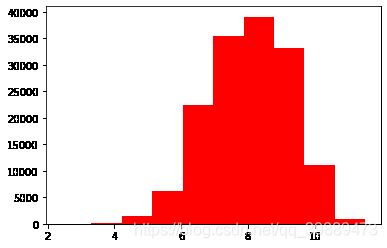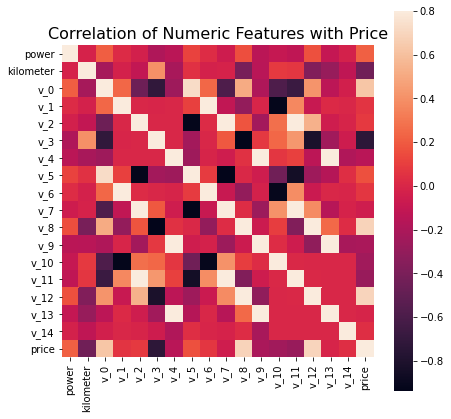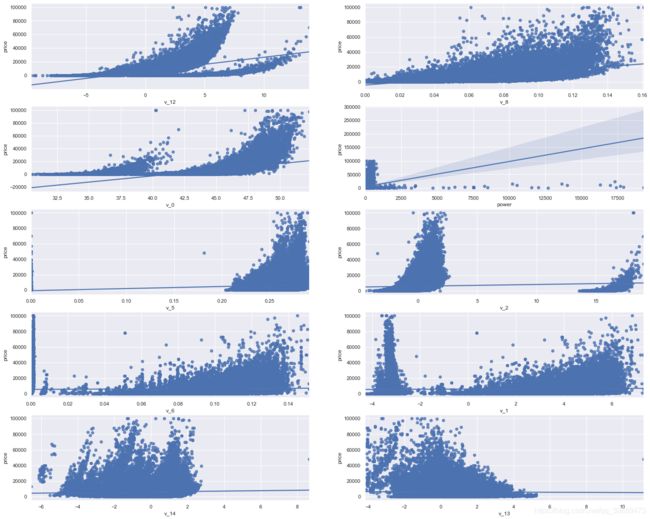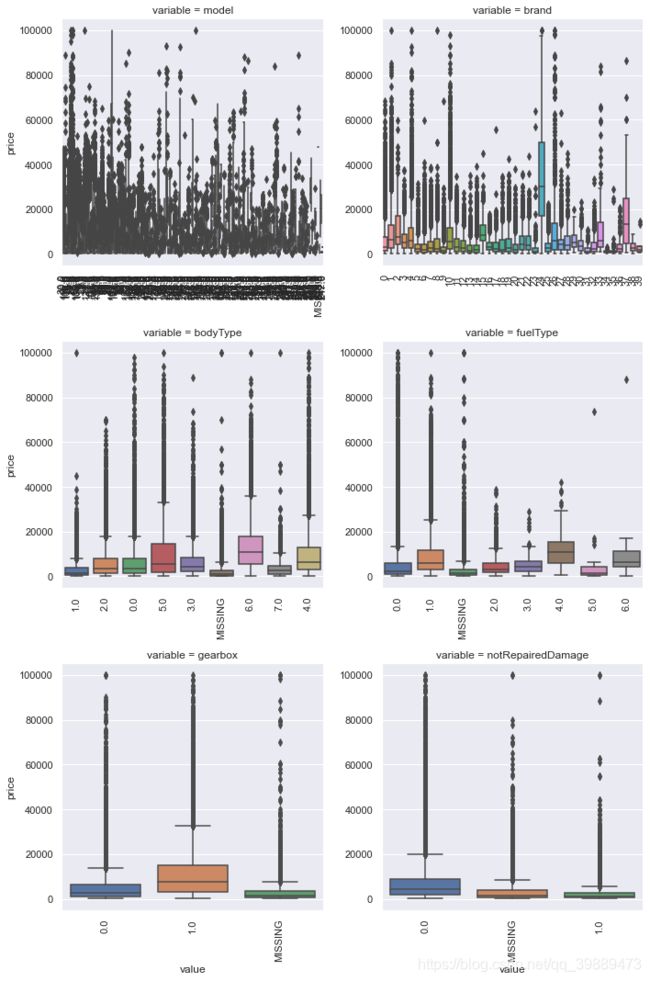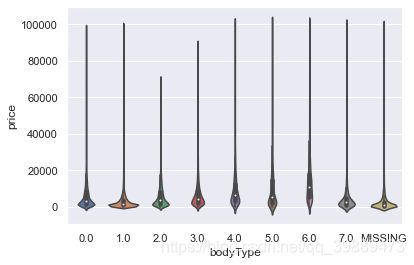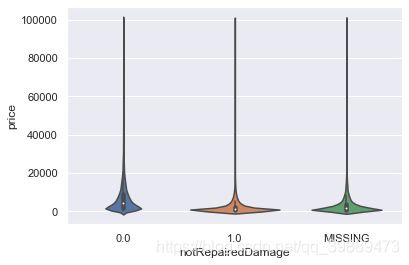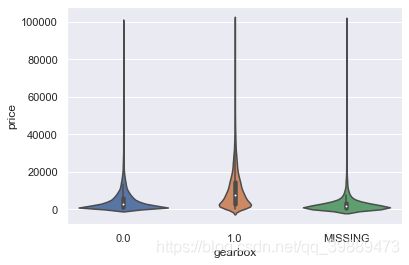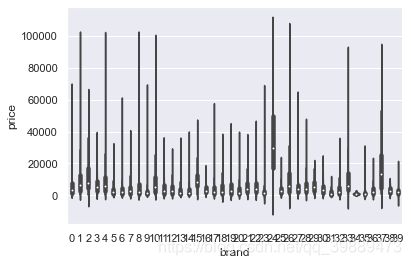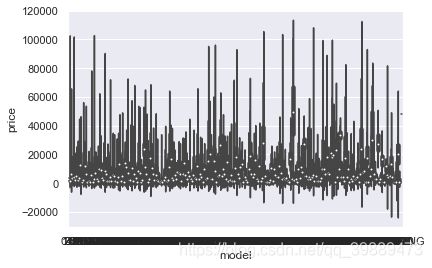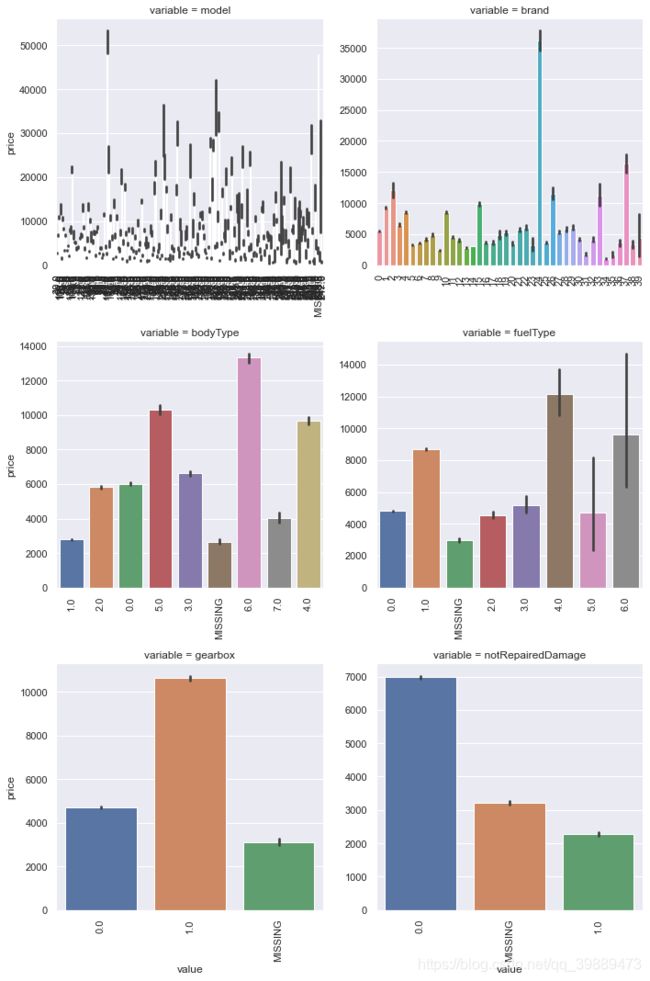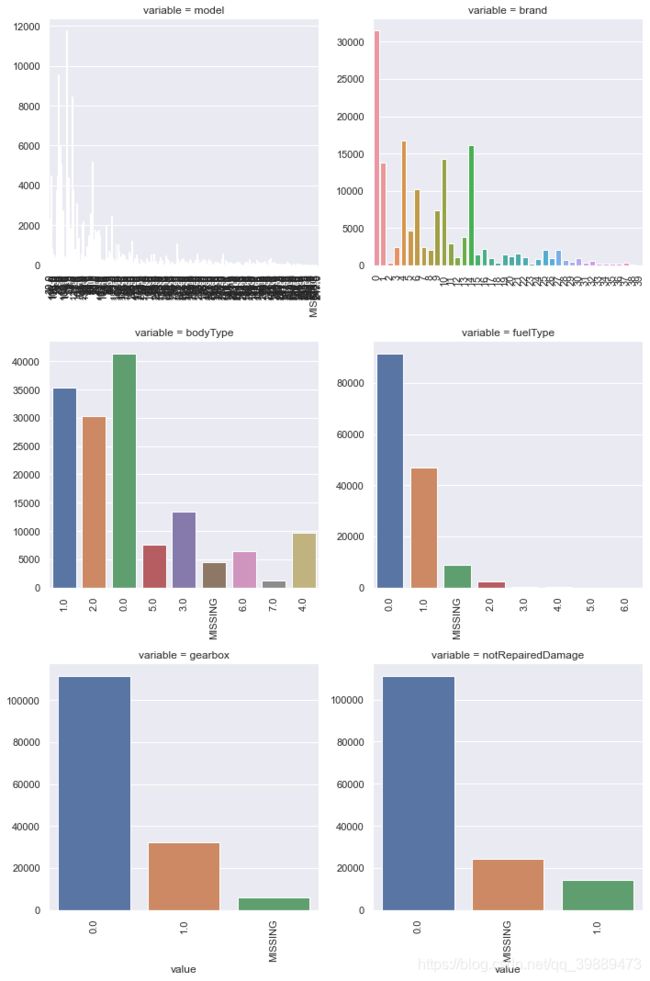二手车价格预测---数据分析
一、代码示例
#1.1载入各种数据库科学以及可视化库
!pip show matplotlib
Name: matplotlib
Version: 3.0.3
Summary: Python plotting package
Home-page: http://matplotlib.org
Author: John D. Hunter, Michael Droettboom
Author-email: [email protected]
License: PSF
Location: e:\program files\anaconda3\lib\site-packages
Requires: pyparsing, kiwisolver, cycler, python-dateutil, numpy
Required-by: seaborn, scikit-image, missingno
#coding:utf-8
#导入warnings包,利用过滤器来实现忽略警告语句。
import warnings
warnings.filterwarnings('ignore')
import pandas as pd
import numpy as np
import matplotlib.pyplot as plt
import seaborn as sns
import missingno as msno#missingno库提供了一个灵活易用的可视化工具来观察数据缺失情况
#1.2载入数据集
##1)载入训练集和测试集
Train_data=pd.read_csv('./data/train.csv',sep=' ')
Test_data=pd.read_csv('./data/testA.csv',sep=' ')
##2)简略观察数据(head()+shape)
Train_data.head().append(Train_data.tail())#查看前五个和后五个数据
| SaleID | name | regDate | model | brand | bodyType | fuelType | gearbox | power | kilometer | ... | v_5 | v_6 | v_7 | v_8 | v_9 | v_10 | v_11 | v_12 | v_13 | v_14 | |
|---|---|---|---|---|---|---|---|---|---|---|---|---|---|---|---|---|---|---|---|---|---|
| 0 | 0 | 736 | 20040402 | 30.0 | 6 | 1.0 | 0.0 | 0.0 | 60 | 12.5 | ... | 0.235676 | 0.101988 | 0.129549 | 0.022816 | 0.097462 | -2.881803 | 2.804097 | -2.420821 | 0.795292 | 0.914762 |
| 1 | 1 | 2262 | 20030301 | 40.0 | 1 | 2.0 | 0.0 | 0.0 | 0 | 15.0 | ... | 0.264777 | 0.121004 | 0.135731 | 0.026597 | 0.020582 | -4.900482 | 2.096338 | -1.030483 | -1.722674 | 0.245522 |
| 2 | 2 | 14874 | 20040403 | 115.0 | 15 | 1.0 | 0.0 | 0.0 | 163 | 12.5 | ... | 0.251410 | 0.114912 | 0.165147 | 0.062173 | 0.027075 | -4.846749 | 1.803559 | 1.565330 | -0.832687 | -0.229963 |
| 3 | 3 | 71865 | 19960908 | 109.0 | 10 | 0.0 | 0.0 | 1.0 | 193 | 15.0 | ... | 0.274293 | 0.110300 | 0.121964 | 0.033395 | 0.000000 | -4.509599 | 1.285940 | -0.501868 | -2.438353 | -0.478699 |
| 4 | 4 | 111080 | 20120103 | 110.0 | 5 | 1.0 | 0.0 | 0.0 | 68 | 5.0 | ... | 0.228036 | 0.073205 | 0.091880 | 0.078819 | 0.121534 | -1.896240 | 0.910783 | 0.931110 | 2.834518 | 1.923482 |
| 149995 | 149995 | 163978 | 20000607 | 121.0 | 10 | 4.0 | 0.0 | 1.0 | 163 | 15.0 | ... | 0.280264 | 0.000310 | 0.048441 | 0.071158 | 0.019174 | 1.988114 | -2.983973 | 0.589167 | -1.304370 | -0.302592 |
| 149996 | 149996 | 184535 | 20091102 | 116.0 | 11 | 0.0 | 0.0 | 0.0 | 125 | 10.0 | ... | 0.253217 | 0.000777 | 0.084079 | 0.099681 | 0.079371 | 1.839166 | -2.774615 | 2.553994 | 0.924196 | -0.272160 |
| 149997 | 149997 | 147587 | 20101003 | 60.0 | 11 | 1.0 | 1.0 | 0.0 | 90 | 6.0 | ... | 0.233353 | 0.000705 | 0.118872 | 0.100118 | 0.097914 | 2.439812 | -1.630677 | 2.290197 | 1.891922 | 0.414931 |
| 149998 | 149998 | 45907 | 20060312 | 34.0 | 10 | 3.0 | 1.0 | 0.0 | 156 | 15.0 | ... | 0.256369 | 0.000252 | 0.081479 | 0.083558 | 0.081498 | 2.075380 | -2.633719 | 1.414937 | 0.431981 | -1.659014 |
| 149999 | 149999 | 177672 | 19990204 | 19.0 | 28 | 6.0 | 0.0 | 1.0 | 193 | 12.5 | ... | 0.284475 | 0.000000 | 0.040072 | 0.062543 | 0.025819 | 1.978453 | -3.179913 | 0.031724 | -1.483350 | -0.342674 |
10 rows × 31 columns
Train_data.shape
(150000, 31)
Test_data.head().append(Test_data.tail())
| SaleID | name | regDate | model | brand | bodyType | fuelType | gearbox | power | kilometer | ... | v_5 | v_6 | v_7 | v_8 | v_9 | v_10 | v_11 | v_12 | v_13 | v_14 | |
|---|---|---|---|---|---|---|---|---|---|---|---|---|---|---|---|---|---|---|---|---|---|
| 0 | 150000 | 66932 | 20111212 | 222.0 | 4 | 5.0 | 1.0 | 1.0 | 313 | 15.0 | ... | 0.264405 | 0.121800 | 0.070899 | 0.106558 | 0.078867 | -7.050969 | -0.854626 | 4.800151 | 0.620011 | -3.664654 |
| 1 | 150001 | 174960 | 19990211 | 19.0 | 21 | 0.0 | 0.0 | 0.0 | 75 | 12.5 | ... | 0.261745 | 0.000000 | 0.096733 | 0.013705 | 0.052383 | 3.679418 | -0.729039 | -3.796107 | -1.541230 | -0.757055 |
| 2 | 150002 | 5356 | 20090304 | 82.0 | 21 | 0.0 | 0.0 | 0.0 | 109 | 7.0 | ... | 0.260216 | 0.112081 | 0.078082 | 0.062078 | 0.050540 | -4.926690 | 1.001106 | 0.826562 | 0.138226 | 0.754033 |
| 3 | 150003 | 50688 | 20100405 | 0.0 | 0 | 0.0 | 0.0 | 1.0 | 160 | 7.0 | ... | 0.260466 | 0.106727 | 0.081146 | 0.075971 | 0.048268 | -4.864637 | 0.505493 | 1.870379 | 0.366038 | 1.312775 |
| 4 | 150004 | 161428 | 19970703 | 26.0 | 14 | 2.0 | 0.0 | 0.0 | 75 | 15.0 | ... | 0.250999 | 0.000000 | 0.077806 | 0.028600 | 0.081709 | 3.616475 | -0.673236 | -3.197685 | -0.025678 | -0.101290 |
| 49995 | 199995 | 20903 | 19960503 | 4.0 | 4 | 4.0 | 0.0 | 0.0 | 116 | 15.0 | ... | 0.284664 | 0.130044 | 0.049833 | 0.028807 | 0.004616 | -5.978511 | 1.303174 | -1.207191 | -1.981240 | -0.357695 |
| 49996 | 199996 | 708 | 19991011 | 0.0 | 0 | 0.0 | 0.0 | 0.0 | 75 | 15.0 | ... | 0.268101 | 0.108095 | 0.066039 | 0.025468 | 0.025971 | -3.913825 | 1.759524 | -2.075658 | -1.154847 | 0.169073 |
| 49997 | 199997 | 6693 | 20040412 | 49.0 | 1 | 0.0 | 1.0 | 1.0 | 224 | 15.0 | ... | 0.269432 | 0.105724 | 0.117652 | 0.057479 | 0.015669 | -4.639065 | 0.654713 | 1.137756 | -1.390531 | 0.254420 |
| 49998 | 199998 | 96900 | 20020008 | 27.0 | 1 | 0.0 | 0.0 | 1.0 | 334 | 15.0 | ... | 0.261152 | 0.000490 | 0.137366 | 0.086216 | 0.051383 | 1.833504 | -2.828687 | 2.465630 | -0.911682 | -2.057353 |
| 49999 | 199999 | 193384 | 20041109 | 166.0 | 6 | 1.0 | NaN | 1.0 | 68 | 9.0 | ... | 0.228730 | 0.000300 | 0.103534 | 0.080625 | 0.124264 | 2.914571 | -1.135270 | 0.547628 | 2.094057 | -1.552150 |
10 rows × 30 columns
Test_data.shape
(50000, 30)
问题:为什么训练集是31列,测试集是30列呢?
#1.3纵揽数据概况
## 1) 通过describe()来熟悉数据的相关统计量
Train_data.describe()
| SaleID | name | regDate | model | brand | bodyType | fuelType | gearbox | power | kilometer | ... | v_5 | v_6 | v_7 | v_8 | v_9 | v_10 | v_11 | v_12 | v_13 | v_14 | |
|---|---|---|---|---|---|---|---|---|---|---|---|---|---|---|---|---|---|---|---|---|---|
| count | 150000.000000 | 150000.000000 | 1.500000e+05 | 149999.000000 | 150000.000000 | 145494.000000 | 141320.000000 | 144019.000000 | 150000.000000 | 150000.000000 | ... | 150000.000000 | 150000.000000 | 150000.000000 | 150000.000000 | 150000.000000 | 150000.000000 | 150000.000000 | 150000.000000 | 150000.000000 | 150000.000000 |
| mean | 74999.500000 | 68349.172873 | 2.003417e+07 | 47.129021 | 8.052733 | 1.792369 | 0.375842 | 0.224943 | 119.316547 | 12.597160 | ... | 0.248204 | 0.044923 | 0.124692 | 0.058144 | 0.061996 | -0.001000 | 0.009035 | 0.004813 | 0.000313 | -0.000688 |
| std | 43301.414527 | 61103.875095 | 5.364988e+04 | 49.536040 | 7.864956 | 1.760640 | 0.548677 | 0.417546 | 177.168419 | 3.919576 | ... | 0.045804 | 0.051743 | 0.201410 | 0.029186 | 0.035692 | 3.772386 | 3.286071 | 2.517478 | 1.288988 | 1.038685 |
| min | 0.000000 | 0.000000 | 1.991000e+07 | 0.000000 | 0.000000 | 0.000000 | 0.000000 | 0.000000 | 0.000000 | 0.500000 | ... | 0.000000 | 0.000000 | 0.000000 | 0.000000 | 0.000000 | -9.168192 | -5.558207 | -9.639552 | -4.153899 | -6.546556 |
| 25% | 37499.750000 | 11156.000000 | 1.999091e+07 | 10.000000 | 1.000000 | 0.000000 | 0.000000 | 0.000000 | 75.000000 | 12.500000 | ... | 0.243615 | 0.000038 | 0.062474 | 0.035334 | 0.033930 | -3.722303 | -1.951543 | -1.871846 | -1.057789 | -0.437034 |
| 50% | 74999.500000 | 51638.000000 | 2.003091e+07 | 30.000000 | 6.000000 | 1.000000 | 0.000000 | 0.000000 | 110.000000 | 15.000000 | ... | 0.257798 | 0.000812 | 0.095866 | 0.057014 | 0.058484 | 1.624076 | -0.358053 | -0.130753 | -0.036245 | 0.141246 |
| 75% | 112499.250000 | 118841.250000 | 2.007111e+07 | 66.000000 | 13.000000 | 3.000000 | 1.000000 | 0.000000 | 150.000000 | 15.000000 | ... | 0.265297 | 0.102009 | 0.125243 | 0.079382 | 0.087491 | 2.844357 | 1.255022 | 1.776933 | 0.942813 | 0.680378 |
| max | 149999.000000 | 196812.000000 | 2.015121e+07 | 247.000000 | 39.000000 | 7.000000 | 6.000000 | 1.000000 | 19312.000000 | 15.000000 | ... | 0.291838 | 0.151420 | 1.404936 | 0.160791 | 0.222787 | 12.357011 | 18.819042 | 13.847792 | 11.147669 | 8.658418 |
8 rows × 30 columns
Test_data.describe()
| SaleID | name | regDate | model | brand | bodyType | fuelType | gearbox | power | kilometer | ... | v_5 | v_6 | v_7 | v_8 | v_9 | v_10 | v_11 | v_12 | v_13 | v_14 | |
|---|---|---|---|---|---|---|---|---|---|---|---|---|---|---|---|---|---|---|---|---|---|
| count | 50000.000000 | 50000.000000 | 5.000000e+04 | 50000.000000 | 50000.000000 | 48587.000000 | 47107.000000 | 48090.000000 | 50000.000000 | 50000.000000 | ... | 50000.000000 | 50000.000000 | 50000.000000 | 50000.000000 | 50000.000000 | 50000.000000 | 50000.000000 | 50000.000000 | 50000.000000 | 50000.000000 |
| mean | 174999.500000 | 68542.223280 | 2.003393e+07 | 46.844520 | 8.056240 | 1.782185 | 0.373405 | 0.224350 | 119.883620 | 12.595580 | ... | 0.248669 | 0.045021 | 0.122744 | 0.057997 | 0.062000 | -0.017855 | -0.013742 | -0.013554 | -0.003147 | 0.001516 |
| std | 14433.901067 | 61052.808133 | 5.368870e+04 | 49.469548 | 7.819477 | 1.760736 | 0.546442 | 0.417158 | 185.097387 | 3.908979 | ... | 0.044601 | 0.051766 | 0.195972 | 0.029211 | 0.035653 | 3.747985 | 3.231258 | 2.515962 | 1.286597 | 1.027360 |
| min | 150000.000000 | 0.000000 | 1.991000e+07 | 0.000000 | 0.000000 | 0.000000 | 0.000000 | 0.000000 | 0.000000 | 0.500000 | ... | 0.000000 | 0.000000 | 0.000000 | 0.000000 | 0.000000 | -9.160049 | -5.411964 | -8.916949 | -4.123333 | -6.112667 |
| 25% | 162499.750000 | 11203.500000 | 1.999091e+07 | 10.000000 | 1.000000 | 0.000000 | 0.000000 | 0.000000 | 75.000000 | 12.500000 | ... | 0.243762 | 0.000044 | 0.062644 | 0.035084 | 0.033714 | -3.700121 | -1.971325 | -1.876703 | -1.060428 | -0.437920 |
| 50% | 174999.500000 | 52248.500000 | 2.003091e+07 | 29.000000 | 6.000000 | 1.000000 | 0.000000 | 0.000000 | 109.000000 | 15.000000 | ... | 0.257877 | 0.000815 | 0.095828 | 0.057084 | 0.058764 | 1.613212 | -0.355843 | -0.142779 | -0.035956 | 0.138799 |
| 75% | 187499.250000 | 118856.500000 | 2.007110e+07 | 65.000000 | 13.000000 | 3.000000 | 1.000000 | 0.000000 | 150.000000 | 15.000000 | ... | 0.265328 | 0.102025 | 0.125438 | 0.079077 | 0.087489 | 2.832708 | 1.262914 | 1.764335 | 0.941469 | 0.681163 |
| max | 199999.000000 | 196805.000000 | 2.015121e+07 | 246.000000 | 39.000000 | 7.000000 | 6.000000 | 1.000000 | 20000.000000 | 15.000000 | ... | 0.291618 | 0.153265 | 1.358813 | 0.156355 | 0.214775 | 12.338872 | 18.856218 | 12.950498 | 5.913273 | 2.624622 |
8 rows × 29 columns
## 2) 通过info()来熟悉数据类型
Train_data.info()
RangeIndex: 150000 entries, 0 to 149999
Data columns (total 31 columns):
# Column Non-Null Count Dtype
--- ------ -------------- -----
0 SaleID 150000 non-null int64
1 name 150000 non-null int64
2 regDate 150000 non-null int64
3 model 149999 non-null float64
4 brand 150000 non-null int64
5 bodyType 145494 non-null float64
6 fuelType 141320 non-null float64
7 gearbox 144019 non-null float64
8 power 150000 non-null int64
9 kilometer 150000 non-null float64
10 notRepairedDamage 150000 non-null object
11 regionCode 150000 non-null int64
12 seller 150000 non-null int64
13 offerType 150000 non-null int64
14 creatDate 150000 non-null int64
15 price 150000 non-null int64
16 v_0 150000 non-null float64
17 v_1 150000 non-null float64
18 v_2 150000 non-null float64
19 v_3 150000 non-null float64
20 v_4 150000 non-null float64
21 v_5 150000 non-null float64
22 v_6 150000 non-null float64
23 v_7 150000 non-null float64
24 v_8 150000 non-null float64
25 v_9 150000 non-null float64
26 v_10 150000 non-null float64
27 v_11 150000 non-null float64
28 v_12 150000 non-null float64
29 v_13 150000 non-null float64
30 v_14 150000 non-null float64
dtypes: float64(20), int64(10), object(1)
memory usage: 35.5+ MB
Test_data.info()
RangeIndex: 50000 entries, 0 to 49999
Data columns (total 30 columns):
# Column Non-Null Count Dtype
--- ------ -------------- -----
0 SaleID 50000 non-null int64
1 name 50000 non-null int64
2 regDate 50000 non-null int64
3 model 50000 non-null float64
4 brand 50000 non-null int64
5 bodyType 48587 non-null float64
6 fuelType 47107 non-null float64
7 gearbox 48090 non-null float64
8 power 50000 non-null int64
9 kilometer 50000 non-null float64
10 notRepairedDamage 50000 non-null object
11 regionCode 50000 non-null int64
12 seller 50000 non-null int64
13 offerType 50000 non-null int64
14 creatDate 50000 non-null int64
15 v_0 50000 non-null float64
16 v_1 50000 non-null float64
17 v_2 50000 non-null float64
18 v_3 50000 non-null float64
19 v_4 50000 non-null float64
20 v_5 50000 non-null float64
21 v_6 50000 non-null float64
22 v_7 50000 non-null float64
23 v_8 50000 non-null float64
24 v_9 50000 non-null float64
25 v_10 50000 non-null float64
26 v_11 50000 non-null float64
27 v_12 50000 non-null float64
28 v_13 50000 non-null float64
29 v_14 50000 non-null float64
dtypes: float64(20), int64(9), object(1)
memory usage: 11.4+ MB
#1判断数据缺失和异常
##1)查看每列的存在的nan情况
Train_data.isnull().sum()
SaleID 0
name 0
regDate 0
model 1
brand 0
bodyType 4506
fuelType 8680
gearbox 5981
power 0
kilometer 0
notRepairedDamage 0
regionCode 0
seller 0
offerType 0
creatDate 0
price 0
v_0 0
v_1 0
v_2 0
v_3 0
v_4 0
v_5 0
v_6 0
v_7 0
v_8 0
v_9 0
v_10 0
v_11 0
v_12 0
v_13 0
v_14 0
dtype: int64
Test_data.isnull().sum()
SaleID 0
name 0
regDate 0
model 0
brand 0
bodyType 1413
fuelType 2893
gearbox 1910
power 0
kilometer 0
notRepairedDamage 0
regionCode 0
seller 0
offerType 0
creatDate 0
v_0 0
v_1 0
v_2 0
v_3 0
v_4 0
v_5 0
v_6 0
v_7 0
v_8 0
v_9 0
v_10 0
v_11 0
v_12 0
v_13 0
v_14 0
dtype: int64
#nan可视化
missing=Train_data.isnull().sum()
missing=missing[missing>0]
missing.sort_values(inplace=True)
missing.plot.bar()
通过以上两句可以很直观的了解哪些列存在 “nan”, 并可以把nan的个数打印,主要的目的在于 nan存在的个数是否真的很大,如果很小一般选择填充,如果使用lgb等树模型可以直接空缺,让树自己去优化,但如果nan存在的过多、可以考虑删掉
# 可视化看下缺省值
msno.matrix(Train_data.sample(250))#表示抽250个样本,白线越多,说明缺失值越多
msno.bar(Train_data.sample(500))
#可视化看缺省值
msno.matrix(Test_data.sample(250))
msno.bar(Test_data.sample(1000))
测试集的缺省和训练集的差不多情况, 可视化有3列有缺省,fuelType缺省得最多
##2)查看异常值检测
Train_data.info()
RangeIndex: 150000 entries, 0 to 149999
Data columns (total 31 columns):
# Column Non-Null Count Dtype
--- ------ -------------- -----
0 SaleID 150000 non-null int64
1 name 150000 non-null int64
2 regDate 150000 non-null int64
3 model 149999 non-null float64
4 brand 150000 non-null int64
5 bodyType 145494 non-null float64
6 fuelType 141320 non-null float64
7 gearbox 144019 non-null float64
8 power 150000 non-null int64
9 kilometer 150000 non-null float64
10 notRepairedDamage 150000 non-null object
11 regionCode 150000 non-null int64
12 seller 150000 non-null int64
13 offerType 150000 non-null int64
14 creatDate 150000 non-null int64
15 price 150000 non-null int64
16 v_0 150000 non-null float64
17 v_1 150000 non-null float64
18 v_2 150000 non-null float64
19 v_3 150000 non-null float64
20 v_4 150000 non-null float64
21 v_5 150000 non-null float64
22 v_6 150000 non-null float64
23 v_7 150000 non-null float64
24 v_8 150000 non-null float64
25 v_9 150000 non-null float64
26 v_10 150000 non-null float64
27 v_11 150000 non-null float64
28 v_12 150000 non-null float64
29 v_13 150000 non-null float64
30 v_14 150000 non-null float64
dtypes: float64(20), int64(10), object(1)
memory usage: 35.5+ MB
上面初识数据的时候,我们使用data.info()看到了各个字段的类型,发现当时有一个object字段,这种记得要单独拿出来看一下取值.
可以发现除了notRepairedDamage 为object类型其他都为数字 这里我们把他的几个不同的值都进行显示就知道了
Train_data['notRepairedDamage'].value_counts()
0.0 111361
- 24324
1.0 14315
Name: notRepairedDamage, dtype: int64
Train_data['notRepairedDamage'].replace('-', np.nan, inplace=True)
Train_data['notRepairedDamage'].value_counts()
0.0 111361
1.0 14315
Name: notRepairedDamage, dtype: int64
Train_data.isnull().sum()
SaleID 0
name 0
regDate 0
model 1
brand 0
bodyType 4506
fuelType 8680
gearbox 5981
power 0
kilometer 0
notRepairedDamage 24324
regionCode 0
seller 0
offerType 0
creatDate 0
price 0
v_0 0
v_1 0
v_2 0
v_3 0
v_4 0
v_5 0
v_6 0
v_7 0
v_8 0
v_9 0
v_10 0
v_11 0
v_12 0
v_13 0
v_14 0
dtype: int64
Test_data['notRepairedDamage'].value_counts()
0.0 37249
- 8031
1.0 4720
Name: notRepairedDamage, dtype: int64
Test_data['notRepairedDamage'].replace('-', np.nan, inplace=True)
这里应该的查看每一列的value_counts.(以下两个类别特征严重倾斜,一般不会对预测有什么帮助,故这边先删掉,当然你也可以继续挖掘,但是一般意义不大
Train_data["seller"].value_counts()
0 149999
1 1
Name: seller, dtype: int64
Train_data["offerType"].value_counts()
0 150000
Name: offerType, dtype: int64
del Train_data["seller"]
del Train_data["offerType"]
del Test_data["seller"]
del Test_data["offerType"]
#1.5了解预测值的分布
Train_data['price']
0 1850
1 3600
2 6222
3 2400
4 5200
...
149995 5900
149996 9500
149997 7500
149998 4999
149999 4700
Name: price, Length: 150000, dtype: int64
Train_data['price'].value_counts()
500 2337
1500 2158
1200 1922
1000 1850
2500 1821
...
1433 1
8911 1
12877 1
9885 1
8188 1
Name: price, Length: 3763, dtype: int64
## 1) 总体分布概况(无界约翰逊分布等)
import scipy.stats as st
y = Train_data['price']
plt.figure(1); plt.title('Johnson SU')
sns.distplot(y, kde=False, fit=st.johnsonsu)
plt.figure(2); plt.title('Normal')
sns.distplot(y, kde=False, fit=st.norm)
plt.figure(3); plt.title('Log Normal')
sns.distplot(y, kde=False, fit=st.lognorm)
价格不服从正态分布,所以在进行回归之前,它必须进行转换。虽然对数变换做得很好,但最佳拟合是无界约翰逊分布
## 2) 查看skewness and kurtosis
sns.distplot(Train_data['price']);
print("Skewness: %f" % Train_data['price'].skew())
print("Kurtosis: %f" % Train_data['price'].kurt())
Skewness: 3.346487
Kurtosis: 18.995183
峰度Kurt代表数据分布顶的尖锐程度。偏度skew简单来说就是数据的不对称程度https://www.cnblogs.com/wyy1480/p/10474046.html
Train_data.skew(),Train_data.kurt()
(SaleID 0.000000
name 0.557606
regDate 0.028495
model 1.484388
brand 1.150760
bodyType 0.991530
fuelType 1.595486
gearbox 1.317514
power 65.863178
kilometer -1.525921
notRepairedDamage 2.430640
regionCode 0.688881
creatDate -79.013310
price 3.346487
v_0 -1.316712
v_1 0.359454
v_2 4.842556
v_3 0.106292
v_4 0.367989
v_5 -4.737094
v_6 0.368073
v_7 5.130233
v_8 0.204613
v_9 0.419501
v_10 0.025220
v_11 3.029146
v_12 0.365358
v_13 0.267915
v_14 -1.186355
dtype: float64,
SaleID -1.200000
name -1.039945
regDate -0.697308
model 1.740483
brand 1.076201
bodyType 0.206937
fuelType 5.880049
gearbox -0.264161
power 5733.451054
kilometer 1.141934
notRepairedDamage 3.908072
regionCode -0.340832
creatDate 6881.080328
price 18.995183
v_0 3.993841
v_1 -1.753017
v_2 23.860591
v_3 -0.418006
v_4 -0.197295
v_5 22.934081
v_6 -1.742567
v_7 25.845489
v_8 -0.636225
v_9 -0.321491
v_10 -0.577935
v_11 12.568731
v_12 0.268937
v_13 -0.438274
v_14 2.393526
dtype: float64)
sns.distplot(Train_data.skew(),color='blue',axlabel ='Skewness')
sns.distplot(Train_data.kurt(),color='orange',axlabel ='Kurtness')
## 3) 查看预测值的具体频数
plt.hist(Train_data['price'], orientation = 'vertical',histtype = 'bar', color ='red')
plt.show()
查看频数, 大于20000得值极少,其实这里也可以把这些当作特殊得值(异常值)直接用填充或者删掉,再前面进行
# log变换 z之后的分布较均匀,可以进行log变换进行预测,这也是预测问题常用的trick
plt.hist(np.log(Train_data['price']), orientation = 'vertical',histtype = 'bar', color ='red')
plt.show()
#1.6特征分为类别特征和数字特征,并对类别特征查看unique分布
# 分离label即预测值
Y_train = Train_data['price']
# 这个区别方式适用于没有直接label coding的数据
# 这里不适用,需要人为根据实际含义来区分
# 数字特征
# numeric_features = Train_data.select_dtypes(include=[np.number])
# numeric_features.columns
# # 类型特征
# categorical_features = Train_data.select_dtypes(include=[np.object])
# categorical_features.columns
numeric_features = ['power', 'kilometer', 'v_0', 'v_1', 'v_2', 'v_3', 'v_4', 'v_5', 'v_6', 'v_7', 'v_8', 'v_9', 'v_10', 'v_11', 'v_12', 'v_13','v_14' ]
categorical_features = ['name', 'model', 'brand', 'bodyType', 'fuelType', 'gearbox', 'notRepairedDamage', 'regionCode',]
# 特征nunique分布
for cat_fea in categorical_features:
print(cat_fea + "的特征分布如下:")
print("{}特征有个{}不同的值".format(cat_fea, Train_data[cat_fea].nunique()))
print(Train_data[cat_fea].value_counts())
name的特征分布如下:
name特征有个99662不同的值
387 282
708 282
55 280
1541 263
203 233
...
26403 1
28450 1
32544 1
102174 1
184730 1
Name: name, Length: 99662, dtype: int64
model的特征分布如下:
model特征有个248不同的值
0.0 11762
19.0 9573
4.0 8445
1.0 6038
29.0 5186
...
242.0 2
209.0 2
245.0 2
240.0 2
247.0 1
Name: model, Length: 248, dtype: int64
brand的特征分布如下:
brand特征有个40不同的值
0 31480
4 16737
14 16089
10 14249
1 13794
6 10217
9 7306
5 4665
13 3817
11 2945
3 2461
7 2361
16 2223
8 2077
25 2064
27 2053
21 1547
15 1458
19 1388
20 1236
12 1109
22 1085
26 966
30 940
17 913
24 772
28 649
32 592
29 406
37 333
2 321
31 318
18 316
36 228
34 227
33 218
23 186
35 180
38 65
39 9
Name: brand, dtype: int64
bodyType的特征分布如下:
bodyType特征有个8不同的值
0.0 41420
1.0 35272
2.0 30324
3.0 13491
4.0 9609
5.0 7607
6.0 6482
7.0 1289
Name: bodyType, dtype: int64
fuelType的特征分布如下:
fuelType特征有个7不同的值
0.0 91656
1.0 46991
2.0 2212
3.0 262
4.0 118
5.0 45
6.0 36
Name: fuelType, dtype: int64
gearbox的特征分布如下:
gearbox特征有个2不同的值
0.0 111623
1.0 32396
Name: gearbox, dtype: int64
notRepairedDamage的特征分布如下:
notRepairedDamage特征有个2不同的值
0.0 111361
1.0 14315
Name: notRepairedDamage, dtype: int64
regionCode的特征分布如下:
regionCode特征有个7905不同的值
419 369
764 258
125 137
176 136
462 134
...
7081 1
7243 1
7319 1
7742 1
7960 1
Name: regionCode, Length: 7905, dtype: int64
# 特征nunique分布
for cat_fea in categorical_features:
print(cat_fea + "的特征分布如下:")
print("{}特征有个{}不同的值".format(cat_fea, Test_data[cat_fea].nunique()))
print(Test_data[cat_fea].value_counts())
name的特征分布如下:
name特征有个37453不同的值
55 97
708 96
387 95
1541 88
713 74
..
131595 1
135689 1
25095 1
29158 1
67583 1
Name: name, Length: 37453, dtype: int64
model的特征分布如下:
model特征有个247不同的值
0.0 3896
19.0 3245
4.0 3007
1.0 1981
29.0 1742
...
244.0 1
242.0 1
240.0 1
243.0 1
246.0 1
Name: model, Length: 247, dtype: int64
brand的特征分布如下:
brand特征有个40不同的值
0 10348
4 5763
14 5314
10 4766
1 4532
6 3502
9 2423
5 1569
13 1245
11 919
7 795
3 773
16 771
8 704
25 695
27 650
21 544
15 511
20 450
19 450
12 389
22 363
30 324
17 317
26 303
24 268
28 225
32 193
29 117
31 115
18 106
2 104
37 92
34 77
33 76
36 67
23 62
35 53
38 23
39 2
Name: brand, dtype: int64
bodyType的特征分布如下:
bodyType特征有个8不同的值
0.0 13985
1.0 11882
2.0 9900
3.0 4433
4.0 3303
5.0 2537
6.0 2116
7.0 431
Name: bodyType, dtype: int64
fuelType的特征分布如下:
fuelType特征有个7不同的值
0.0 30656
1.0 15544
2.0 774
3.0 72
4.0 37
6.0 14
5.0 10
Name: fuelType, dtype: int64
gearbox的特征分布如下:
gearbox特征有个2不同的值
0.0 37301
1.0 10789
Name: gearbox, dtype: int64
notRepairedDamage的特征分布如下:
notRepairedDamage特征有个2不同的值
0.0 37249
1.0 4720
Name: notRepairedDamage, dtype: int64
regionCode的特征分布如下:
regionCode特征有个6971不同的值
419 146
764 78
188 52
759 51
125 51
...
5733 1
6451 1
3654 1
5701 1
6937 1
Name: regionCode, Length: 6971, dtype: int64
#1.7数字特征分析
numeric_features.append('price')
numeric_features
['power',
'kilometer',
'v_0',
'v_1',
'v_2',
'v_3',
'v_4',
'v_5',
'v_6',
'v_7',
'v_8',
'v_9',
'v_10',
'v_11',
'v_12',
'v_13',
'v_14',
'price']
Train_data.head()
| SaleID | name | regDate | model | brand | bodyType | fuelType | gearbox | power | kilometer | ... | v_5 | v_6 | v_7 | v_8 | v_9 | v_10 | v_11 | v_12 | v_13 | v_14 | |
|---|---|---|---|---|---|---|---|---|---|---|---|---|---|---|---|---|---|---|---|---|---|
| 0 | 0 | 736 | 20040402 | 30.0 | 6 | 1.0 | 0.0 | 0.0 | 60 | 12.5 | ... | 0.235676 | 0.101988 | 0.129549 | 0.022816 | 0.097462 | -2.881803 | 2.804097 | -2.420821 | 0.795292 | 0.914762 |
| 1 | 1 | 2262 | 20030301 | 40.0 | 1 | 2.0 | 0.0 | 0.0 | 0 | 15.0 | ... | 0.264777 | 0.121004 | 0.135731 | 0.026597 | 0.020582 | -4.900482 | 2.096338 | -1.030483 | -1.722674 | 0.245522 |
| 2 | 2 | 14874 | 20040403 | 115.0 | 15 | 1.0 | 0.0 | 0.0 | 163 | 12.5 | ... | 0.251410 | 0.114912 | 0.165147 | 0.062173 | 0.027075 | -4.846749 | 1.803559 | 1.565330 | -0.832687 | -0.229963 |
| 3 | 3 | 71865 | 19960908 | 109.0 | 10 | 0.0 | 0.0 | 1.0 | 193 | 15.0 | ... | 0.274293 | 0.110300 | 0.121964 | 0.033395 | 0.000000 | -4.509599 | 1.285940 | -0.501868 | -2.438353 | -0.478699 |
| 4 | 4 | 111080 | 20120103 | 110.0 | 5 | 1.0 | 0.0 | 0.0 | 68 | 5.0 | ... | 0.228036 | 0.073205 | 0.091880 | 0.078819 | 0.121534 | -1.896240 | 0.910783 | 0.931110 | 2.834518 | 1.923482 |
5 rows × 29 columns
## 1) 相关性分析,其他特征与价格的相关性
price_numeric = Train_data[numeric_features]
correlation = price_numeric.corr()
print(correlation['price'].sort_values(ascending = False),'\n')
price 1.000000
v_12 0.692823
v_8 0.685798
v_0 0.628397
power 0.219834
v_5 0.164317
v_2 0.085322
v_6 0.068970
v_1 0.060914
v_14 0.035911
v_13 -0.013993
v_7 -0.053024
v_4 -0.147085
v_9 -0.206205
v_10 -0.246175
v_11 -0.275320
kilometer -0.440519
v_3 -0.730946
Name: price, dtype: float64
f , ax = plt.subplots(figsize = (7, 7))
plt.title('Correlation of Numeric Features with Price',y=1,size=16)
sns.heatmap(correlation,square = True, vmax=0.8)
del price_numeric['price']
## 2) 查看几个特征得 偏度和峰值
for col in numeric_features:
print('{:15}'.format(col),
'Skewness: {:05.2f}'.format(Train_data[col].skew()) ,
' ' ,
'Kurtosis: {:06.2f}'.format(Train_data[col].kurt())
)
power Skewness: 65.86 Kurtosis: 5733.45
kilometer Skewness: -1.53 Kurtosis: 001.14
v_0 Skewness: -1.32 Kurtosis: 003.99
v_1 Skewness: 00.36 Kurtosis: -01.75
v_2 Skewness: 04.84 Kurtosis: 023.86
v_3 Skewness: 00.11 Kurtosis: -00.42
v_4 Skewness: 00.37 Kurtosis: -00.20
v_5 Skewness: -4.74 Kurtosis: 022.93
v_6 Skewness: 00.37 Kurtosis: -01.74
v_7 Skewness: 05.13 Kurtosis: 025.85
v_8 Skewness: 00.20 Kurtosis: -00.64
v_9 Skewness: 00.42 Kurtosis: -00.32
v_10 Skewness: 00.03 Kurtosis: -00.58
v_11 Skewness: 03.03 Kurtosis: 012.57
v_12 Skewness: 00.37 Kurtosis: 000.27
v_13 Skewness: 00.27 Kurtosis: -00.44
v_14 Skewness: -1.19 Kurtosis: 002.39
price Skewness: 03.35 Kurtosis: 019.00
## 3) 每个数字特征得分布可视化
f = pd.melt(Train_data, value_vars=numeric_features)
g = sns.FacetGrid(f, col="variable", col_wrap=2, sharex=False, sharey=False)
g = g.map(sns.distplot, "value")
## 4) 数字特征相互之间的关系可视化
sns.set()
columns = ['price', 'v_12', 'v_8' , 'v_0', 'power', 'v_5', 'v_2', 'v_6', 'v_1', 'v_14']
sns.pairplot(Train_data[columns],size = 2 ,kind ='scatter',diag_kind='kde')
plt.show()
Train_data.columns
Index(['SaleID', 'name', 'regDate', 'model', 'brand', 'bodyType', 'fuelType',
'gearbox', 'power', 'kilometer', 'notRepairedDamage', 'regionCode',
'creatDate', 'price', 'v_0', 'v_1', 'v_2', 'v_3', 'v_4', 'v_5', 'v_6',
'v_7', 'v_8', 'v_9', 'v_10', 'v_11', 'v_12', 'v_13', 'v_14'],
dtype='object')
Y_train
0 1850
1 3600
2 6222
3 2400
4 5200
...
149995 5900
149996 9500
149997 7500
149998 4999
149999 4700
Name: price, Length: 150000, dtype: int64
此处是多变量之间的关系可视化,可视化更多学习可参考很不错的文章 https://www.jianshu.com/p/6e18d21a4cad
## 5) 多变量互相回归关系可视化
fig, ((ax1, ax2), (ax3, ax4), (ax5, ax6), (ax7, ax8), (ax9, ax10)) = plt.subplots(nrows=5, ncols=2, figsize=(24, 20))
# ['v_12', 'v_8' , 'v_0', 'power', 'v_5', 'v_2', 'v_6', 'v_1', 'v_14']
v_12_scatter_plot = pd.concat([Y_train,Train_data['v_12']],axis = 1)
sns.regplot(x='v_12',y = 'price', data = v_12_scatter_plot,scatter= True, fit_reg=True, ax=ax1)
v_8_scatter_plot = pd.concat([Y_train,Train_data['v_8']],axis = 1)
sns.regplot(x='v_8',y = 'price',data = v_8_scatter_plot,scatter= True, fit_reg=True, ax=ax2)
v_0_scatter_plot = pd.concat([Y_train,Train_data['v_0']],axis = 1)
sns.regplot(x='v_0',y = 'price',data = v_0_scatter_plot,scatter= True, fit_reg=True, ax=ax3)
power_scatter_plot = pd.concat([Y_train,Train_data['power']],axis = 1)
sns.regplot(x='power',y = 'price',data = power_scatter_plot,scatter= True, fit_reg=True, ax=ax4)
v_5_scatter_plot = pd.concat([Y_train,Train_data['v_5']],axis = 1)
sns.regplot(x='v_5',y = 'price',data = v_5_scatter_plot,scatter= True, fit_reg=True, ax=ax5)
v_2_scatter_plot = pd.concat([Y_train,Train_data['v_2']],axis = 1)
sns.regplot(x='v_2',y = 'price',data = v_2_scatter_plot,scatter= True, fit_reg=True, ax=ax6)
v_6_scatter_plot = pd.concat([Y_train,Train_data['v_6']],axis = 1)
sns.regplot(x='v_6',y = 'price',data = v_6_scatter_plot,scatter= True, fit_reg=True, ax=ax7)
v_1_scatter_plot = pd.concat([Y_train,Train_data['v_1']],axis = 1)
sns.regplot(x='v_1',y = 'price',data = v_1_scatter_plot,scatter= True, fit_reg=True, ax=ax8)
v_14_scatter_plot = pd.concat([Y_train,Train_data['v_14']],axis = 1)
sns.regplot(x='v_14',y = 'price',data = v_14_scatter_plot,scatter= True, fit_reg=True, ax=ax9)
v_13_scatter_plot = pd.concat([Y_train,Train_data['v_13']],axis = 1)
sns.regplot(x='v_13',y = 'price',data = v_13_scatter_plot,scatter= True, fit_reg=True, ax=ax10)
#1.8类别特征分析
## 1) unique分布
for fea in categorical_features:
print(Train_data[fea].nunique())
99662
248
40
8
7
2
2
7905
categorical_features
['name',
'model',
'brand',
'bodyType',
'fuelType',
'gearbox',
'notRepairedDamage',
'regionCode']
## 2) 类别特征箱形图可视化
# 因为 name和 regionCode的类别太稀疏了,这里我们把不稀疏的几类画一下
categorical_features = ['model',
'brand',
'bodyType',
'fuelType',
'gearbox',
'notRepairedDamage']
for c in categorical_features:
Train_data[c] = Train_data[c].astype('category')
if Train_data[c].isnull().any():
Train_data[c] = Train_data[c].cat.add_categories(['MISSING'])
Train_data[c] = Train_data[c].fillna('MISSING')
def boxplot(x, y, **kwargs):
sns.boxplot(x=x, y=y)
x=plt.xticks(rotation=90)
f = pd.melt(Train_data, id_vars=['price'], value_vars=categorical_features)
g = sns.FacetGrid(f, col="variable", col_wrap=2, sharex=False, sharey=False, size=5)
g = g.map(boxplot, "value", "price")
## 3) 类别特征的小提琴图可视化
catg_list = categorical_features
target = 'price'
for catg in catg_list :
sns.violinplot(x=catg, y=target, data=Train_data)
plt.show()
categorical_features = ['model',
'brand',
'bodyType',
'fuelType',
'gearbox',
'notRepairedDamage']
## 4) 类别特征的柱形图可视化
def bar_plot(x, y, **kwargs):
sns.barplot(x=x, y=y)
x=plt.xticks(rotation=90)
f = pd.melt(Train_data, id_vars=['price'], value_vars=categorical_features)
g = sns.FacetGrid(f, col="variable", col_wrap=2, sharex=False, sharey=False, size=5)
g = g.map(bar_plot, "value", "price")
## 5) 类别特征的每个类别频数可视化(count_plot)
def count_plot(x, **kwargs):
sns.countplot(x=x)
x=plt.xticks(rotation=90)
f = pd.melt(Train_data, value_vars=categorical_features)
g = sns.FacetGrid(f, col="variable", col_wrap=2, sharex=False, sharey=False, size=5)
g = g.map(count_plot, "value")
#1.9用pandas_profiling生成数据报告
import pandas_profiling
pfr = pandas_profiling.ProfileReport(Train_data)
pfr.to_file("./example.html")
Summarize dataset: 0%| | 0/42 [00:00二、经验总结
所给出的EDA步骤为广为普遍的步骤,在实际的不管是工程还是比赛过程中,这只是最开始的一步,也是最基本的一步。
接下来一般要结合模型的效果以及特征工程等来分析数据的实际建模情况,根据自己的一些理解,查阅文献,对实际问题做出判断和深入的理解。
最后不断进行EDA与数据处理和挖掘,来到达更好的数据结构和分布以及较为强势相关的特征
数据探索在机器学习中我们一般称为EDA(Exploratory Data Analysis):
是指对已有的数据(特别是调查或观察得来的原始数据)在尽量少的先验假定下进行探索,通过作图、制表、方程拟合、计算特征量等手段探索数据的结构和规律的一种数据分析方法。
数据探索有利于我们发现数据的一些特性,数据之间的关联性,对于后续的特征构建是很有帮助的。
-
对于数据的初步分析(直接查看数据,或.sum(), .mean(),.descirbe()等统计函数)可以从:样本数量,训练集数量,是否有时间特征,是否是时许问题,特征所表示的含义(非匿名特征),特征类型(字符类似,int,float,time),特征的缺失情况(注意缺失的在数据中的表现形式,有些是空的有些是”NAN”符号等),特征的均值方差情况。
-
分析记录某些特征值缺失占比30%以上样本的缺失处理,有助于后续的模型验证和调节,分析特征应该是填充(填充方式是什么,均值填充,0填充,众数填充等),还是舍去,还是先做样本分类用不同的特征模型去预测。
-
对于异常值做专门的分析,分析特征异常的label是否为异常值(或者偏离均值较远或者事特殊符号),异常值是否应该剔除,还是用正常值填充,是记录异常,还是机器本身异常等。
-
对于Label做专门的分析,分析标签的分布情况等。
-
进步分析可以通过对特征作图,特征和label联合做图(统计图,离散图),直观了解特征的分布情况,通过这一步也可以发现数据之中的一些异常值等,通过箱型图分析一些特征值的偏离情况,对于特征和特征联合作图,对于特征和label联合作图,分析其中的一些关联性。
